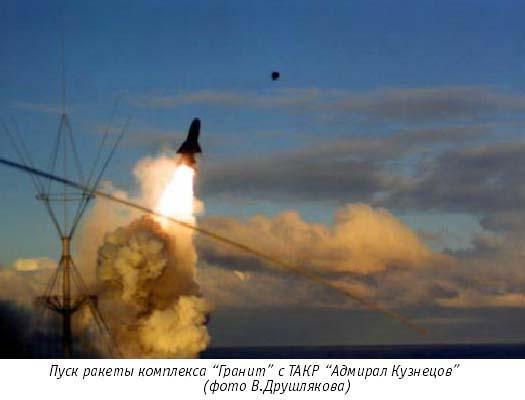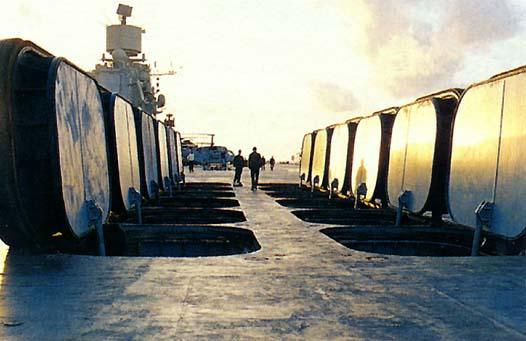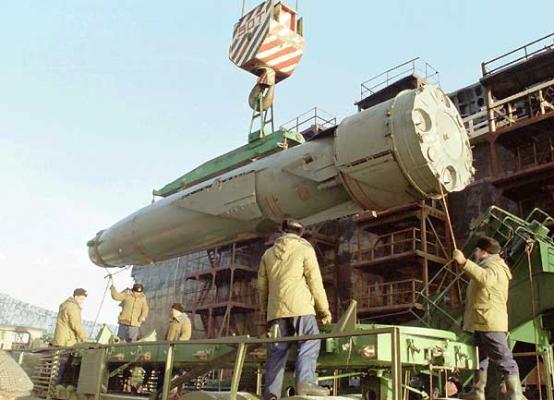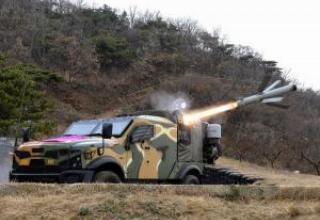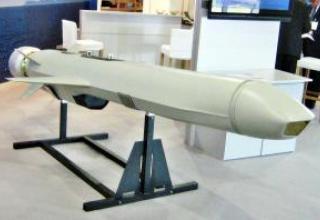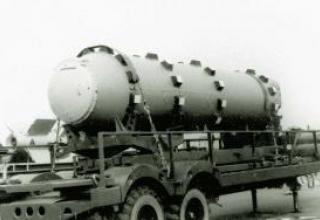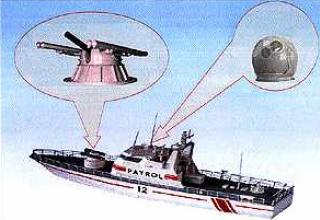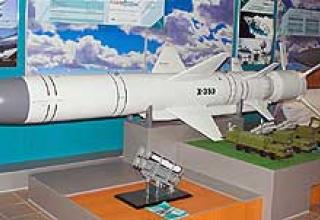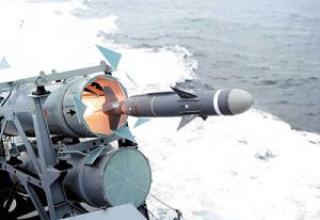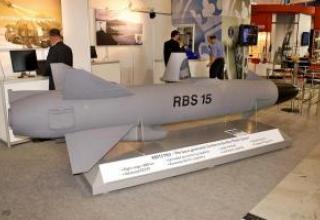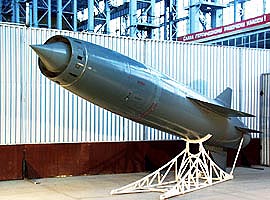
The Granit universal missile system with a P-700 anti-ship cruise missile of underwater launch is designed to engage NATO carrier groups.
The main organization - NPO Engineering. Chief Designer - Vladimir Chelomey (since 1984 - Herbert Efremov). The development was started in 1969. The complex was presented for state tests in 1979. Tests were carried out on shore stands and head ships: the submarine and the cruiser "Kirov". The tests were successfully completed in August 1983, and by the Decree of the USSR Council of Ministers dated March 12, 1983 the complex "Granite" was adopted for service by the Navy.
In the process of creating the "Granit" complex for the first time, all the main allies of the branched out cooperation have worked out a lot (up to one or two dozen) of options for the design of the cruise missile, on-board control system, the submarine. Then these options were evaluated by combat efficiency, cost and timing of creation, feasibility, and on the basis of analysis were formulated requirements for the cruise missile and other elements of the weapons system. As a result, the created complex for the first time got the opportunity to solve any problem of sea battle with a single carrier firefighting equipment.
Since the creation of the first PCR, capable of hitting surface ships at very long ranges, the question of providing anti-ship missiles with target designation data. On a global scale, this problem could only be solved by means of spacecraft. The theoretical basis for the construction of such a space system, the parameters of their orbits and the mutual position of satellites in orbit have been developed with the direct participation of Academician M.V.Keldysh. The system consisted of several radar and radiotechnical reconnaissance satellites from which data on detected targets could be transmitted directly to CD carriers or to ground stations.
In the west, the missile was designated SS-N-19 "Shipwreck".
Composition:
Onboard autonomous selective control system PCR is built on the basis of a powerful three-processor computer with the use of several information channels, which allows you to successfully understand the complex interference situation and highlight the true targets against any interference. This system was created by a team of scientists and designers of the Central Research Institute "Granit" under the guidance of its General Director, Hero of Socialist Labor, Lenin Prize winner V.V. Pavlov.
The 3M-45 (P-700) missile has several flexible adaptive trajectories depending on the operational and tactical situation in the sea and air space of the operation area. Its maximum flight speed corresponds to M=2.5 at high altitude and M=1.5 at low altitude. The complex provides salvo firing of all ammunition with a rational spatial arrangement of missiles and allows to act against a single ship on the principle of "one missile-one ship" or "flock" against a ship order.
In Runaway Fire mode, one missile acting as a "gunner" flies on a high trajectory to maximize the target area, while other missiles fly on a low trajectory. In flight, the missiles exchange information about their targets. If a guided missile is intercepted, then one of the other missiles automatically takes over its functions. The missiles themselves distribute and classify according to the importance of the target, choose the tactics of the attack and its plan. To exclude errors in the choice of maneuver and hit the target in the onboard computer (BCVM) embedded electronic data on modern classes of ships. In addition, the BCVM has tactical information, for example, about the type of warrants ships, which allows the missile to determine whether it is in front of a convoy, aircraft carrier or landing party, and to attack the main targets in its composition. The BCVM contains data on countermeasures against enemy electronic warfare, capable of setting interference to take missiles away from the target, tactical evasion techniques of air defense means. After the missile is launched, it is up to them to decide which of them will attack which target and what maneuvers to perform this in accordance with the mathematical algorithms laid down in the program of behavior. The missile also has the means to counteract the attackers of its anti-missile. Having destroyed the main target in the ship's group, the remaining missiles will attack other ships of the warrant, excluding the possibility of two missiles hitting the same target.
The missile has a turbojet engine KR-93 (developed at the Design Bureau of the Ufa Engine Building Software under the supervision of Chief Designer Sergey Gavrilov) and a solid fuel ring accelerator in the tail end, which starts to operate underwater. A variant of the rocket with an experimental 4D 04 supersonic direct current engine developed at Design Bureau-670 under the leadership of Mikhail Bondaryuk allowed the rocket to reach a speed of 4M.
According to the experience of combat and operational training of the Navy, it is almost impossible to shoot down such a missile. Even if you hit Granit with an anti-missile, the missile, because of its huge mass and speed, can maintain its initial flight speed and as a result reach the target.
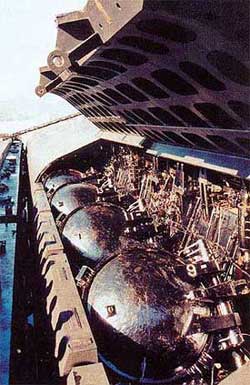
Rocket complex "Granit" is armed with 12 nuclear submarine cruisers (NSC) project 949A type "Antey", 24 PCR each, with a submarine speed of over 30 knots. The SM-225A launcher placed at the agro-industrial complex of this project is designed to provide storage and launch conditions for ZM45 or ZM15 cruise missiles both at underwater and surface positions. Launching unit SM-225A is placed in a container PL, installed at a constant angle. Inside the container on the longitudinal holding device there is a glass with rails and it is loosened through transverse shock absorbers to PL container walls. Transverse shock absorbers are placed in a sealed dry volume formed by the container wall, the glass and two rubber-cord shells (RCE).
Each submarine cruiser is ten times cheaper than the U.S. Navy aircraft carrier type "Nimitz". This is our asymmetric and economical response to the aircraft-borne threat. There are no other forces in the Russian Armed Forces that can really counteract this threat. Taking into account the ongoing upgrades of the carriers, the missile system and the Granit rocket launcher, the created group is capable of operating effectively until 2020. Naturally, at the same time it is necessary to develop and maintain combat control, reconnaissance and target designation systems.
In addition to combating AUG, the group's combat units are able to act not only against ships of all classes during armed conflicts of any intensity, but also effectively hit missiles with a conventional target unit on the enemy's coast. If necessary, ships with the "Granit" complex can be a reserve for the Maritime Strategic Nuclear Forces.
Four heavy nuclear missile cruisers of Project 1144 (type "Peter the Great") carry 20 missiles each in individual sub-deck launchers SM-233 (designed by Special Engineering Design Bureau), with an elevation angle of 60°.
Technical solutions during development of the SM-233 PU were aimed at meeting the following main requirements:
- unification and borrowing of mechanisms and assembly units of PU SM-233 with launch unit SM-225 of RO "Granit" submarine of project 949;
- improving the reliability of missile launch by reducing the number of operations in the combat cycle.
On the ship, the PPs are placed in a sub-deck room at an angle to the horizon in four rows of five units each along the ship's diameter plane. The overall dimensions of the deck apertures are determined from the conditions of safe missile exit during launch and loading. The PU were delivered from the shipyard to the ship fully assembled, tested and verified in the scope of the factory test programs and TU, which significantly reduced the time for assembly, debugging and testing on the ship. Deck openings are closed by protective covers with structural protection against shell splinters by hydraulic drives. Covers are opened (closed) according to a pre-determined cyclogram as the missiles are launched. On the upper deck and on the covers there are seating places for installation of the deck loading device.
Based on the decision of the Ministry of Justice, Ministry of Bashkortostan and Navy from 05.02.82 ¹ 1/0018 in 1982 began work on the creation of PU SM-233A complex RO "Granit" for the ship project 1143.5 ("Admiral of the Fleet of the Soviet Union Kuznetsov, Chief Designer VF Anikiev).
During the development of the PU SM-233A, technical decisions were made aimed at increasing the tactical and technical characteristics and technical and economic performance of the SM-233 unit:
- Increasing readiness and reliability by reducing the number of mechanisms and devices involved during the prelaunch preparation and launch of the missile;
- Reducing labour and cost costs by reducing metal consumption and simplifying the design of labour-intensive units and mechanisms;
- Reducing the amount and time of maintenance and simplifying the conditions for its implementation;
- improving the repairability of the launcher by simplifying the design of mechanisms;
- reducing the number of mutual connections between the PU and the ship's systems.
The ship of project 1143.5 is equipped with 12 SM-233A launchers. The launchers are placed under the upper deck with a constant elevation angle. Inside the hull of the PU, on the hinged supports of the longitudinal holding device, there is a glass-fiberglass cup with rails and it is loosened to the walls of the hull through transverse damping. From above the PU is hermetically sealed by a cover with a protective kit and a radio camouflage device.
Characteristics:
| Range, km | 600 |
| Flight Speed, M | 2.5 |
| The length of the rocket, m | 10 |
| Maximum rocket body diameter, m | 0.88 |
| Wingspan, m | 2.6 |
| Start weight, kg | 7000 |
| Weight of the blast unit, kg | 750 |
| Nuclear warhead power, kt. | 500 |
Testing:
In the period from October 10, 1969 to December 20, 1969, at the P6766 substation enterprise, the "cassette warfare unit for antipersonnel mining to the "Partizan" system was tested (subject MKV2-6I-69)". See photo.
See also the Conclusion on the results of the tests of the upgraded Grad-P mobile jet system. (cipher - "Partisan")
Alekseev Alexander Timofeyevich, worker of the Central KIB SOO Alekseev took part in the creation of the launch unit 9P132.
Sources:
- А.Б.Широкорад "Оружие отечественного флота", Минск, Харвест, 2001г.
- http://www.fas.org
- П-700 "Гранит" /Настоящие сверхзвуковые!
